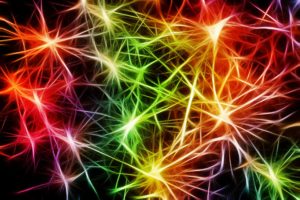Dr. Gordon Irving was the medical director of the Pain center at Swedish Hospital in Seattle, WA. He developed a wonderful set of resources for dealing with chronic pain. His version of a structured program was STOMP (Structuring Your Own Management of Pain). He and I co-edited this guide that will link you to many resources, which will enable you to take charge of your care.
“You Can Only Lose Brain Cells”
Historically scientists have thought that a person was born with a maximum number of neurons and you would slowly lose them over a lifetime. Although the brain activity the first few years of life is intense it has been clearly shown that the brain can change at any age—for better or worse.

Neuroplasticity
Neuroplasticity is the term that refers to the ability of the brain to adapt and change. It is your choice whether you want to direct in a positive or negative direction. Your brain will develop wherever you place your attention. Several of the ways it can occur are:
- Growth of new nerve cells (neurons)
- Shrinking of neurons from disuse
- Increasing or decreasing the number of connections per neuron
- Laying down or losing layers of insulation (myelin). This layer improves the speed of nerve conduction
- Substitution of an injured part of the brain with an already functioning area. The new area takes on new capacities.
The bottom line is that your brain is constantly in a dynamic state of change every millisecond, depending on how much it is stimulated—or not.
- There is an incredible upside potential because the nervous system has a large capacity to continue to positively change if it is kept active and creative.
- The terrible dark side is that when your brain shrinks or atrophies when suffering from chronic pain, then you have less ability to act rationally to pull yourself out of the hole. It is still a solvable problem, but you need help and tools.
Brain Changes are Measurable
With the advent of modern brain scans that can actually measure brain size and activity we are able to document these changes and they happen quickly.
A recent study showed that certain parts of medical students’ brains would significantly enlarge within a few months after starting school. (1)
It has also been shown that the brains of patients in chronic pain shrink. Fortunately the brain also re-expands with successful resolution of their pain. (2)
Brain Shrinks??
Why would your brain shrink in the presence of chronic pain? Conceptually, your nervous system gets stuck on repetitive thought and pain patterns that grow into monstrous circuits, and less time is spent on creative ones. The brain area that enjoys good friends, music, art, wine, etc. gradually shrinks with disuse. There is a huge amount of neural activity involved with these enjoyable endeavors that just does not occur in the presence of unrelenting pain.
Once pain circuits are laid down in your brain they are permanent. They may become less functional but they are not going to disappear. Once you know how to ride a bicycle or walk you cannot unlearn the skill.
Creating Detours

So what is the solution? You must lay down alternate pathways or detours around the existing problematic pathways, or you can create a shift on to more enjoyable ones. Once you learn the tools and choose the ones that are the best fit for you it is remarkable how consistently the pain will diminish and may even disappear.
There are three aspects of healing:
- Awareness – You must understand chronic pain as it relates to you before you can solve it.
- Treating all aspects of your pain simultaneously – similar to fighting a forest fire.
- You take charge – each human is incredibly unique and complex. You are the only one who can find your own solution.
Welcome to a big adventure and the evolution of your new brain. It will be you that will do the brain building. The STOMP program is a variation of the DOC concepts, and you will discover additional approaches to help move you forward. They are both frameworks for you to organize your thinking and break your problem down into its component parts. The best news is that the healing journey is largely self-directed and you will learn to find the best resources that will work for you. We have found that chronic pain is not a life sentence to be managed, but is solvable.
- Dragananski, et al. Temporal and spatial dynamics of brain structure changes during extensive learning. The Journal of Neuroscience 2006; 26: 6314-6317.
- Apkarian AV, Sosa Y, Sonty S. Chronic Back Pain is associated with decreased prefrontal and thalamic gray matter density. Journal of Neuroscience 2004; 24: 10410 -10415.
